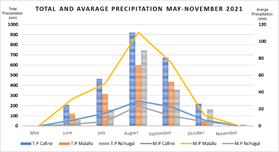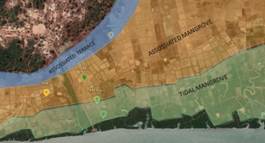INTRODUCTION
Mangrove swamp rice cultivation is one of the most productive systems globally, but highly dependent on regular and abundant rainfall, unpredictable tidal height and intensive labour force; thus, it is a system greatly affected by climate change and significant socio-economic transformations (Temudo & Santos, 2017).
Within the framework of the Malmon project “Mangroves, mangrove rice and mangrove people - sustainably improving rice production, ecosystems and livelihoods”, funded by the European Union (DeSIRA/ FOOD/2019/412-700), this work ultimately aims at contributing to increasing the productivity and stabilising the inter-annual mangrove swamp rice production in Guinea-Bissau.
Sustainable alternatives, such as rice intercropping systems are not yet considerd in these agroecological systems, due to the particular swamp conditions of the soils. To meet the plant’s nutrient needs, the provision in N-P-K by fertilizer input is economically unsustainable for the farmers´ but also risks the environmental sustainability of these very sensitive agroecological systems. The use of organic fertilizers can be environmentally sustainable and can lead to significant increases in organic matter levels and plant-available N-P-K in the soil, busting production (Moe et al., 2019).
MATERIAL AND METHODS
Research Area Characterisation
This study uses a multi-site approach, located in 5 villages from two different coastal regions (Oio and Tombali) in Guinea Bissau. Oio is located between the basins of the two big rivers Mansoa and Geba. Tombali is located between Cumbija and Cacine river basins. Having a tropical humid climate, the average annual rainfall ranges from 1.500 mm in the north to 2.000 mm in the south. Figure 1 presents the total and average precipitation for three main villages in the study area during the 2021 hydrological season. Temperature projection scenarios systematically signal an increased average up to + 1.4°C and modelled precipitation suggests a reduction up to 10% for period 2016-2045 (UN Convention on Biological Diversity, 2019).

Figure 1 Monthly total and average precipitation for Cafine (Tombali region), Nchugal and Malfu (Oio region); (T.P- Total Precipitation, M.P- Mean/Average Precipitation).
According to the topography, Guinea Bissau is predominantly flat, with average altitude that does not exceed 40 m above sea level. The main types of soils are hydromorphic, divided into marine and continental hydromorphic soils (known as the tropical paddy soils used for the rice cultivation) and the highland soils or ferralitics and tropical ferruginous soils (suitable for annual crops) (Teixeira, 1962). According to the Soil Taxonomy, they are classified mainly as Oxisols, Ultisols and Inceptisols (Van Gent & Ukkerman, 1993).
Research Design and sample collection
A schematic cross section of the catena (Figure 2a) shows four predominant agro-ecologies in both regions: a residual terrace (village), the intermediate terrace (mainly where the animals pasture), the rice field terrace area, and the mangrove terrace.
The rice field terrace is sub-divided into three main agroecological conditions (Figure 2b), as follows: AT - Associated Terrace; AM - Associated Mangrove; TM - Tidal Mangrove.
The design methodology for this study focused mainly on the TM and AM systems (respectively 20% and 80% of the total area), as the AT fields occupy just 10% of the total rice fields. Soil samples in the 20 cm of topsoil were taken in three key moments of the rice production cycle: T1 (dry season - 4 months before the planting), T2 (wet season - during the land preparation, plantation) and T3 (in the moment of rice flowering and grain formation). General soil parameters including pH, EC, C and N content, C/N ratio, P, K and CEC were analyzed for about 141 topsoil samples.
RESULTS AND DISCUSSION
During the 2021 campaign, the observed rice production cycle indicated different schedules/timing for the beginning of the nursery preparation and consequently the transplanting, flowering and grain formation, according to each region. This is due to the dependence on the beginning of the rains and the consequent accumulated precipitation, influencing the entire growth cycle and soil nutritional levels, which clearly depend on the circulation of natural inputs for these ecological conditions.
For the Oio region (Table 1), the TM soils during the dry season showed a slightly topsoil acidity and a trend to neutralize during the production cycle (T2, T3). Conversely, topsoil showed high CEC and salinity values (mainly caused by Na+ high concentrations) during the dry period, the latter gradually decreases during the production cycle. Quantification of key macronutrients level, N-P-K, disclosed higher concentrations during T1, before leaching and, therefore, decreasing slightly during T2 and T3. Generally, our results confirm that these soils have high clay content (60-80%), being classified as clay or silty clay, and having a bulk density of 1.0 to 1.3 g/cm3, which is ideal for plant growth.
Regarding AM rice field, the quantified salinity was not high at T1, although low pH values were observed, and the soils showed to remain slightly acid in T2 and T3 (pH ≈ 6.1). The measured N-P-K levels significantly differed from T1 to T2, T3. This observation may be related to nutrient leaching during the flooding period. In this group, soils showed to be mainly silty loamy to silty clay, with bulk density of 1.4 to 1.6 g/cm3, almost reaching the limit of growth restrictions.
Farmers of Oio make nurseries near their homes, where the topsoil is highly influenced by ferruginous limestone, dominated by coarse textures, and classified in its majority as sandy loam or loamy sand soils. These soils are generally lacking in nutrients and have high restrictions due to high bulk density (> 1.8 g/cm3). Levels of N-P-K are at low critical limits where the only income of organic matter is the scarce shrub and grass vegetation and few cattle manure during their grassing. It was observed pure seedlings quality in nurseries, and high effects of leaf bronzing caused by nutrient deficiency and high iron concentrations.
In the Tombali region, the TM topsoil did not present signs of acidification (pH ≈ 6.5), while salinity levels, even being extremely high during the dry season (EC = 11.54 mS cm-1 at T1), drop to acceptable levels for normal plant growth due to suficient precipitation and drainage. Likewise, the N-P-K availability tends to decrease from T1 to T2 and T3, probably due to nutrient leaching. Similarly to the Oio region, the clay or silty clay TM soils have optimal bulk densities for rice growth. The AM soils, in this region, showed acidification during T1, remaining slightly acid during T2 and T3. Salinity in these fields has fallen to much lower values (EC T1, T2 = 0,58 mS cm-1), while nutrient availability, namely P and K was quantified as twice lower when compared to TM, except of N and C, that showed similar levels of those observed in TM.
Table 1 Results of soil analysis for Oio and Tombali region. Values correspond to average for pH, EC, N%, C/N, P, K and CEC, calculated from 141 soil samples taken in T1 - dry season, T2 - planting/nursery, T3 - flowering/grain formation. TM - 58; AM - 64; Viv.1 - 19, nursery in the Residual Terrace
| pH (H2O) | EC mS/cm | N % | C % | C/N | P mg/g | K mg/g | |||
|---|---|---|---|---|---|---|---|---|---|
| OIO | |||||||||
| TM(T1) | 6.22 | 3.37 | 0.95 | 1.10 | 11.6 | 56.9 | 826.4 | ||
| TM(T2) | 6.83 | 2.48 | 0.14 | 1.16 | 8.3 | 39.5 | 872.0 | ||
| TM(T3) | 6.82 | 1.10 | 0.14 | 1.32 | 9.6 | 36.8 | 628.0 | ||
| AM(T1) | 3.85 | 1.79 | 0.81 | 1.31 | 16.2 | 16.8 | 660.9 | ||
| AM(T2) | 6.09 | 0.67 | 0.15 | 1.47 | 10.0 | 0.9 | 398.8 | ||
| AM(T3) | 6.19 | 0.53 | 0.15 | 1.61 | 10.7 | 22.2 | 332.8 | ||
| Viv.(T1) | 4.99 | 0.06 | 0.70 | 0.80 | 11.6 | 1.8 | 57.2 | ||
| Viv.(T2) | 6.68 | 0.44 | 0.11 | 1.34 | 11.5 | 5.8 | 105.5 | ||
| TOMBALI | |||||||||
| TM(T1) | 6.24 | 11.5 | 1.04 | 1.58 | 15.2 | 57.6 | 1231.8 | ||
| TM(T2) | 6.79 | 1.43 | 0.16 | 1.44 | 9.2 | 55.9 | 747.3 | ||
| TM(T3) | 6.72 | 0.98 | 0.14 | 1.37 | 10.0 | 50.3 | 677.5 | ||
| AM(T1) | 4.77 | 2.59 | 1.13 | 1.54 | 13.6 | 5.7 | 677.5 | ||
| AM(T2) | 6.08 | 0.57 | 0.13 | 1.43 | 10.6 | 17.6 | 332.6 | ||
| AM(T3) | 6.01 | 0.59 | 0.15 | 1.56 | 10.2 | 18.3 | 306.7 | ||
After a comparison between TM of both regions, it clearly stands out that TM in Tombali has a better fertility status especialy in P concentrations and organic metter (% of total C). Despite some salinity problems, even the TM soil at Tombali, although being more saline during T1 (reasonably explained by higher tides in this area), has these problems mitigated throughout the growing season by precipitation and salt leaching.
The same can be confirmed for the comparison of the AM. In Tombali these agroecological systems present a slightly better fertility status.
CONCLUSIONS
Collectively, our results suggest that: (a) There is an eminent need to improve soil conditions in the nurseries, as it is of key importance to have quality seedling for transplantations influencing consequently throughout the growth stages and therefore yield performance (applying organic fertilisers may contribute to a solution); (b) During the dry season, farmers can allow the saline water to enter so they can work the soil. This procedure can improve/enrich the soil by flowing water with suspended matter and killing certain weeds, but this should not be longer than 2 months before the planting, so the accumulated salinity can be washed away by the first rains. As observed in the case of TM trials in Oio, EC of approximately 6 mS cm−1 shows to cause total production losses. Other works also refer equivalent yield loss during the growing cycle under EC conditions of 3.5 mS cm−1, reaching even to 50% of yield loss at EC levels of 9.5 mS cm−1 (Asch et al., 1999); (c) Inorganic fertilization is not an option for the small farmers, as the sustaining incomes form their production is extremely limited. However, proper management of the water use, as well as weed and straw incorporation can increase organic matter, consequently leading to increased nutrient availability and improved soil conditions.















